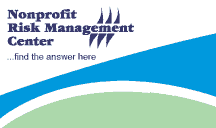| |
December 11, 2008
Fiscal Responsibility and Oversight: Empower Your Board to Lead
By Melanie Lockwood Herman
(This article is excerpted from the Center’s brand-new book, Financial Risk Management: A Guide for Nonprofit Executives. Order your copy.)
While it is rare in a mature nonprofit for a board member to perform day-to-day bookkeeping or financial management duties (such as making journal entries or signing checks), board members exercise overall responsibility for the fiscal affairs of the nonprofits they serve. To discharge this responsibility board members must:
- Have a keen interest in the fiscal affairs of the nonprofit, including its overall, current financial position, the reliability of the reports the board receives, and the effectiveness of the nonprofit’s management of incoming and outgoing funds.
- Require regular, timely and complete financial reports from internal finance staff or contract staff and expect the board to hold staff accountable for meeting the standards of timely reporting (for example, providing financial statements no later than three weeks after the close of the prior accounting period).
- Ask critical questions about the financial reports the board receives, including budgets, periodic financial statements, the annual Form 990 and annual, sometimes audited, financial statements.
Keep in mind that a board that fails on any of the above issues is incapable of meeting its legal duty of care. A CEO who fails to empower the board to discharge its duty of care is arguably derelict as a leader. In many cases the board roster will include several people who are comfortable reviewing nonprofit financial statements. These individuals may volunteer to serve on the finance committee. Other board members may defer to these individuals and refrain from getting involved in the nonprofit’s fiscal affairs. While a talented finance committee is a valuable asset, the remaining board members cannot abdicate their responsibility for providing thoughtful fiscal oversight. Any evidence that one or more board members do not understand the financial presentations should be addressed with prompt training and assistance.
Financial Know-How: Equip Your Board
Training and resource materials combine to offer a powerful antidote to ignorance and lack of confidence in providing fiscal oversight.
Consider:
- Purchasing copies of a how-to-read guide to nonprofit financial statements for each member of your board;
- Scheduling a two-hour training program on nonprofit financial statements as part of the board’s agenda — perhaps the first meeting of your fiscal year; and
- Reaching out to a local CPA whose practice focuses on nonprofits to deliver a briefing to the board and to serve as a resource should members have questions during the year.
*An example of a guide that may be suitable for nonprofit boards is Andrew Lang’s booklet titled, How to Read Nonprofit Financial Statements. The booklet is available from www.asaecenter.org or www.amazon.com.
Board Finance Orientation: A Suggested Agenda
Scheduling a briefing on the nonprofit’s finances and the broader topic of understanding nonprofit financial statements is an important step in empowering the board to provide effective oversight of financial matters. Consider the following suggested elements of a 90-minute orientation; customize the topics, resource materials and timeframe to suit the culture and circumstances of your nonprofit.
Part 1 — Understanding Nonprofit Financial Statements (30 minutes)
Consider starting off with an introduction to nonprofit financial statements. Be aware that the degree of familiarity and comfort with this topic is likely to vary. The goal is to get the entire board in sync with the manner in which financial information will be transmitted to the board, and enable individual board members to feel comfortable asking questions about the nonprofit’s results. To make this segment more productive, consider:
- Providing a list of questions that board members should ask to evaluate the nonprofit’s fiscal health,
- Obtaining copies of a resource document on nonprofit financial statements, such as Understanding Nonprofit Financial Statements from BoardSource (www.boardsource.org), or How to Read Nonprofit Financial Statements from ASAE (www.asaecenter.org), or
- Including magazine or journal articles on the basics of nonprofit budgeting.
Part 2 — Overview of [Name of Nonprofit]’s Finances and Budget (30 minutes)
During this segment the session leader should present a brief overview and analysis of the nonprofit’s Statement of Financial Position, Statement of Activities, and Statement of Cash Flows for the most recently available accounting period. Copies of these documents should be provided as part of the orientation materials.
Part 3 — Additional Finance Resources (30 minutes)
During this segment of the briefing the presenter should call the board’s attention to the resources below, all of which provide a picture of the nonprofit’s fiscal health and financial management strategies. Suggested background materials to support this presentation include:
- Audited financial statements for the year just ended,
- Narrative highlights of the past fiscal year,
- Consolidated schedules of audited statements—five years,
- Approved operating budget for the current year,
- Financial policies and procedures, and
- Investment policies and procedures.
LIVE TRAINING: Board Oversight of Financial Management
Few leaders would argue that boards of directors bear responsibility for providing fiscal oversight of the organizations they serve. Yet there are different approaches to financial oversight by boards. What are the best and most effective practices? What can your staff and volunteer leaders do to increase the financial literacy of your board? The Nonprofit Risk Management Center will host a 60-minute webinar on the topic of board oversight of financial management on Wednesday, January 7th at 2 pm Eastern. The program is the first in a series of 12 programs that will be offered during 2009. Attend the lead-off webinar in our 2009 series to explore ways to balance and enhance the board’s role in providing effective governance oversight for the nonprofit’s financial management policies and activities. Register for this program, or the entire series.
|


